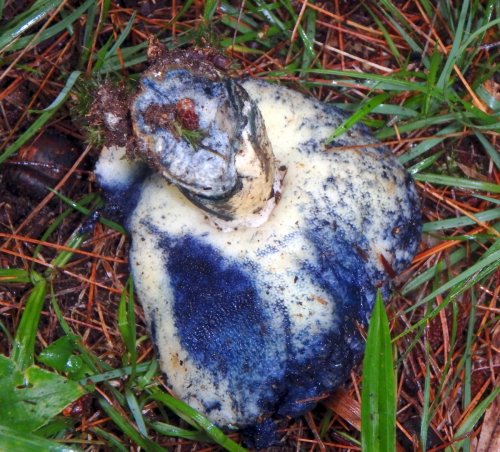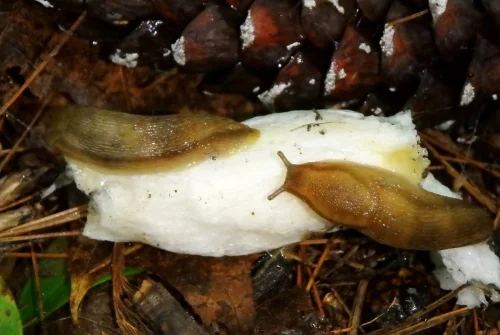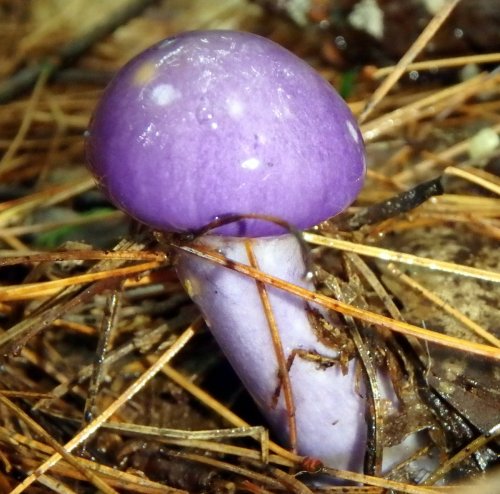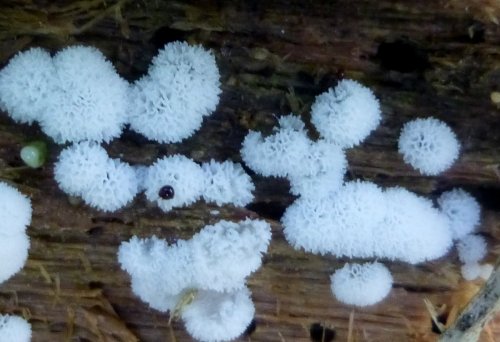I saw quite a few mushrooms in September, including some I’ve never seen before, and I’m still finding them in October. This chicken of the woods (Laetiporus sulphureus) mushroom was the biggest and most colorful. Another common name for them is sulfur shelf though I’ve worked with sulfur and this mushroom doesn’t remind me of it. I’ve read that as they age they lose the orange color but I don’t believe it now because I was able to watch these examples every day and they never lost their orange, even as they rotted away. The name chicken of the woods comes from the way they taste like chicken when cooked. Finding bright colors in the woods at any time of year is always a surprise and I always feel grateful that I was able to see them. This fungus was a beautiful thing and about as big as a soccer ball.
Chicken of the woods is yellow on the underside and has pores rather than gills. The pores are there in this photo but they are far too small to see.
We’ve seen the chicken so now for the hen. Hen of the woods (Grifola frondosa,) is an edible polypore that often grows in the same spot year after year. They are said to look like the back of a brown hen’s ruffled feathers, and that’s how they come by their common name. Though they’re said to be brown I always see green. My color finding software sees bands of gray, peach puff, and rosy brown, which is a surprise. I’ve seen a lot of these this year and every one grew at the base of an oak.
There is a whitish tan mushroom that grows on lawns and in the woods and isn’t very exciting so I’ve always ignored it. After some research I found that it’s called the bluing bolete (Gyroporus cyanescens,) and if I had known that it turned a beautiful cornflower blue where it was bruised I would have looked more closely.
The bluing bolete is said to be edible but I certainly wouldn’t eat it or any mushroom without an expert’s identification. This mushroom contains a compound called variegatic acid which is colorless until it is exposed to oxygen. Once exposed it quickly turns blue, in this case. It can also turn red, I’ve read.
Dyer’s Polypore (Phaeolus schweinitzii) is also called the velvet topped fungus because of its hairy appearance. These fungi are parasitic on the roots and heartwood of living white pines in the eastern U.S. and cause root rot. They also change color as they age. If found when young as this one was it can be used to dye wool a soft yellow or orange and older examples will dye wool brown.
This is what an older dyer’s polypore looks like. As you can see the color difference between young and old examples is dramatic. Some of these mushrooms can get quite large but this one was only about 5 inches across. Though they sometimes look as if they’re growing on the ground as this one does, they’re really growing on conifer roots or buried logs.
If you saw this growing on a fallen branch would you know what it was? I wasn’t absolutely sure until I turned it over.
I knew it was some type of shelf or bracket fungi from the back but I didn’t know it was turkey tails (Trametes versicolor.) I never knew their undersides were so pure white when they were young. When older the underside is kind of off white and full of pores. I also always thought they grew singly, but in clusters. The back view shows they’re actually all one body.
Golden pholiota (Pholiota limonella) mushrooms grew on a birch tree, which is something I’ve never seen before. In fact there are very few mushrooms that I’ve seen growing on a living birch, but these mushrooms can grow on living or dead wood. They appear in the summer and fall and usually form in large clusters. Their orange-yellow caps are slimy and covered in reddish scales. The dim morning light really brought out the golden color of these examples.
Wolf’s milk slime mold (Lycogala epidendrum) starts out as tiny pink globules but as they age and become more like what we see in the above photo. As they grow the globules look more like small puffballs growing on a log.
Wolf’s milk slime mold is also called toothpaste slime and that’s because there is a pinkish orange material inside each globule with (usually) the consistency of toothpaste. It can also have a more liquid consistency as it does here, and that’s the way I usually find it. As it ages it will turn into a mass of brown powdery spores.
Some coral fungi come to a blunt, rather than pointed end and are called club shaped corals. I thought these might be Clavariadelphus truncatus but that mushroom has wrinkles down its length and these are smooth, so I’m not sure what they are. They were no more than an inch tall.
Crown coral fungi come in many colors but I usually find the tan / white varieties. The example in this photo was as big as a baseball (about 3 inches) and had a touch of orange, which I was happy to see. The way to tell if you have a crown coral fungus is by the tips of the branches, which in crown coral look like tiny crowns rather than blunt or rounded. They grow on dead wood but if that wood is buried they can appear to be growing in soil.
Mushroom spores are carried by the wind so it is unusual to see them dropping to the forest floor like they have in the above photo. I’ve only seen this happen three times and twice it was on a still, hot, humid day. This time it was on a cooler but still humid day, without a hint of a breeze to blow the spores away.
An unusual mushroom that I’ve never paid attention to before is the black tooth fungus (Phellodon niger.) One of things that I find unusual about it is how, when they grow close enough together, their caps fuse together creating a large misshapen mass. But as this photo shows they also grow singly, as most of the ones I saw on this day did. Another odd thing about it is how the caps seem to split open on top.
On the underside of the black tooth’s cap are the black “teeth” that give it its common name. The teeth are called spines and the mushroom’s spores form on them. It’s easy to see how the spore bearing surface increases when a mushroom grows pores or spines on its cap. I’ve read that this mushroom is endangered in many countries like Switzerland and parts of the U.K. and there is a danger of its extinction in certain parts of the world. They seem to be abundant in this area.
This bracket fungus had all the makings of a dryad’s saddle (Cerioporus squamosus) except for color. Dryad’s saddle is usually brown but I can’t find any information on whether or not they start out life white before turning brown. I have seen photos of them online where they looked whitish, but that could be due to lighting or camera settings. This one was definitely white all over and as big as a saucer.
One of the things about nature study that some people seem to have trouble with is leaving things dangling, with no answers. When I go into the woods I almost always come back with more questions than answers but quite often, sometimes even years later, the answer comes to me. The question on this day was this grouping of grayish mushrooms growing on a stump. I’ve looked through three mushroom guides and a few websites and haven’t found a single small grayish mushroom with a frayed cap edge. I was fairly sure I’d have trouble identifying them but I wanted their photo anyway, because I thought they were very pretty. Sometimes we have to remind ourselves that mystery is a big part of living, and I’ve had to do so yet again.
These little white mushrooms presented another conundrum but I think they might be one called Xerula megalospora. Unfortunately I’ll probably never be 100% sure, because you need a microscope to see the big, lemon shaped spores and I don’t have one.
What leads me to think that this example might be a Xerula megalospora is how mushroom expert Michael Kuo explains that “its gills are attached to the stem by means of a notch and a tiny tooth that runs down the stem.” For me though, their beauty is more important than their name and this one was quite beautiful; even more so upside down.
There is no end to wonder once one starts really looking.― Marty Rubin
Thanks for coming by.


























































